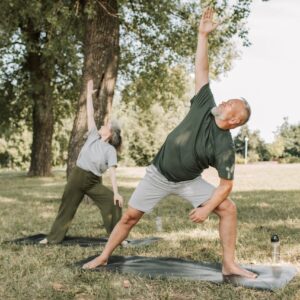Table of Contents
Understanding Functional Strength Training

At its core, functional strength training is not just about bulging muscles or lifting heavy weights; it’s about equipping your body with the strength and agility needed to perform everyday tasks efficiently and effectively. Unlike traditional strength training that often isolates specific muscles, functional strength training focuses on movements that mimic real-life activities. This approach targets multiple muscle groups simultaneously, enhancing overall coordination and stability.
Key Principles of Functional Strength Training
Incorporating Compound Movements
Functional strength training embraces compound movements that engage multiple joints and muscles. Exercises like squats, lunges, deadlifts, and push-ups are staples in functional training routines. These movements mimic natural human motions, improving functional capacity and mobility.
Enhancing Stability and Balance
A crucial aspect of functional strength training is enhancing stability and balance. By incorporating exercises that challenge balance, such as single-leg squats or stability ball exercises, individuals can develop better proprioception and reduce the risk of injury in daily activities.
Emphasizing Core Strength
The core serves as the foundation for all movements, making core strength a focal point in functional training. Exercises like planks, wood chops, and Russian twists target the core muscles, improving posture, spinal alignment, and overall stability.
Integrating Functional Tools
Functional strength training often incorporates various tools and equipment to add diversity and intensity to workouts. From kettlebells and resistance bands to medicine balls and suspension trainers, these tools provide dynamic resistance and instability, mimicking real-world challenges.
Benefits of Functional Strength Training
Enhances Everyday Performance
By targeting movements relevant to daily activities, functional strength training enhances overall performance in tasks like lifting groceries, climbing stairs, or playing sports. Individuals experience improved functionality and efficiency in their day-to-day lives.
Reduces the Risk of Injury
By improving stability, balance, and core strength, functional training helps reduce the risk of injuries, both in everyday activities and during sports or recreational pursuits. Stronger muscles and joints contribute to better movement mechanics and injury prevention.
Improves Joint Health and Flexibility
Functional strength training promotes joint health and flexibility by engaging muscles in a variety of movement patterns. This approach enhances joint mobility and range of motion, reducing stiffness and promoting better overall joint health.
Boosts Metabolism and Fat Loss
Functional training workouts often involve high-intensity intervals and full-body movements, leading to increased calorie burn and metabolic rate. Additionally, the emphasis on building lean muscle mass contributes to long-term fat loss and improved body composition.
Incorporating Functional Strength Training into Your Routine
The Power of Functional Strength Training
Assessing Movement Patterns
Before diving into a functional training programme, it’s essential to assess your movement patterns and identify any weaknesses or imbalances. This assessment can help tailor your workouts to address specific areas of improvement.
Gradual Progression
Start with foundational movements and gradually progress to more complex exercises as your strength and proficiency improve. Focus on mastering proper form and technique before increasing the intensity or resistance.
Balancing Variety and Consistency
While variety is key to preventing boredom and plateauing, consistency is equally important for progress. Incorporate a mix of exercises targeting different muscle groups and movement patterns while maintaining a consistent training schedule.
Listening to Your Body
Pay attention to your body’s signals and adjust your training intensity and volume accordingly. Rest and recovery are essential components of any training programme, allowing your muscles to repair and grow stronger.
Conclusion
Functional strength training offers a holistic approach to fitness, focusing on movements that improve overall functionality, stability, and performance in daily activities. By incorporating compound movements, enhancing stability and balance, and prioritising core strength, individuals can reap the numerous benefits of functional training. Whether you’re a fitness enthusiast looking to elevate your workouts or someone seeking to enhance everyday functionality, integrating functional strength training into your routine can unlock a new level of strength, mobility, and vitality.






